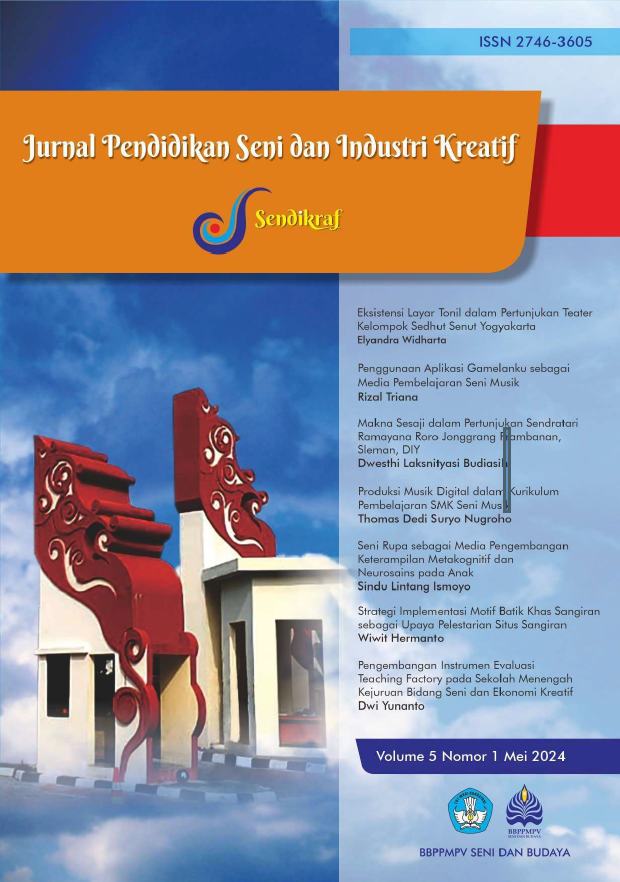SENI RUPA SEBAGAI MEDIA PENGEMBANGAN KETERAMPILAN METAKOGNITIF DAN NEUROSAINS PADA ANAK FINE ARTS AS A TOOL FOR DEVELOPING METACOGNITIVE AND NEUROSCIENCE SKILLS IN CHILDREN
Main Article Content
Abstract
T
This study explores the role of visual arts in developing children's metacognitive skills based on a neuroscience approach. Metacognition, which refers to an individual's awareness and control over their thinking processes, is a crucial skill in children's education to enhance problem-solving, critical thinking, and creativity. This research employs a descriptive-analytical approach through a literature review of various academic sources to analyze the relationship between visual arts, metacognition, and neuroscience in the context of children's education. The findings indicate that visual arts, through their explorative and expressive processes, effectively stimulate neuron development and neural connections in children's brains, as well as enhance metacognitive skills such as self-monitoring and learning strategy evaluation. Activities like drawing and painting not only boost creativity but also improve children's reflection and planning abilities. Integrating arts into the educational curriculum is expected to create a more holistic and effective learning environment, providing significant benefits for children's cognitive, emotional, and social development. This research underscores the importance of arts as an integral component in learning strategies to comprehensively develop students' potential.
Penelitian ini mengeksplorasi peran seni rupa dalam pengembangan keterampilan metakognitif anak berdasarkan pendekatan neurosains. Metakognitif, yang merujuk pada kesadaran dan kontrol individu terhadap proses berpikirnya, merupakan keterampilan penting dalam pendidikan anak untuk meningkatkan pemecahan masalah, berpikir kritis, dan kreatif. Studi ini menggunakan pendekatan deskriptif analitis melalui tinjauan literatur dari berbagai sumber akademik untuk menganalisis hubungan antara seni rupa, metakognitif, dan neurosains dalam konteks pendidikan anak. Hasil penelitian menunjukkan bahwa seni rupa, melalui proses eksploratif dan ekspresifnya, efektif dalam merangsang perkembangan neuron dan koneksi saraf di otak anak, serta meningkatkan keterampilan metakognitif seperti pemantauan diri dan evaluasi strategi belajar. Aktivitas seni seperti menggambar dan melukis tidak hanya meningkatkan kreativitas tetapi juga kemampuan refleksi dan perencanaan anak. Integrasi seni dalam kurikulum pendidikan diharapkan dapat menciptakan lingkungan pembelajaran yang lebih holistik dan efektif, memberikan manfaat signifikan bagi perkembangan kognitif, emosional, dan sosial anak. Penelitian ini menegaskan pentingnya seni sebagai komponen integral dalam strategi pembelajaran untuk mengembangkan potensi siswa secara menyeluruh.
Article Details

This work is licensed under a Creative Commons Attribution-NonCommercial 4.0 International License.
References
Ajeng, A. O. D., Sarniya, A., Saputri, O. E., Siregar, M., & Hasni, U. (2023). Pembelajaran Berbasis Neurosains Dalam Pendidikan Anak Usia Dini. Ana'Bulava: Jurnal Pendidikan Anak, 4(1), 42-57.
Almasitoh, U. H. (2021). Pengembangan Keterampilan Berpikir Tingkat Tinggi Berbasis Strategi Metakognitif Problem Solving pada Siswa Sekolah Dasar di Klaten. Jurnal Ilmiah Aquinas, 4(1), 104-112.
Eisner, E. W. (2002). The Arts and the Creation of Mind. Yale University Press.
Fadilla, F., & Purwaningrum, J. P. (2021). Menumbuhkan Kemampuan Representasi Matematis dan Metakognitif Siswa Kelas XIII SMP Menggunakan Model CORE (Connecting, Organizing, Reflecting, dan Extending). AKSIOMA: Jurnal Matematika dan Pendidikan Matematika, 12(1), 155-168.
Fitri, R. (2017). Metakognitif pada proses belajar anak dalam kajian neurosains. JP (Jurnal Pendidikan): Teori Dan Praktik, 2(1), 56-64.
Flavell, J. H., Green, F. L., & Flavell, E. R. (1990). Developmental changes in young children's knowledge about the mind. Cognitive Development, 5(1), 1-27.
Gracia-Tabuenca, Z., Moreno, M. B., Barrios, F. A., & Alcauter, S. (2021). Development of the brain functional connectome follows puberty- dependent nonlinear trajectories. NeuroImage, 229
Hetland, L., Winner, E., Veenema, S., & Sheridan, K. (2014). Studio Thinking 2: The Real Benefits of Visual Arts Education. New York, NY: Teachers College Press.
Immordino-Yang, M. H., & Damasio, A. (2007). We Feel, Therefore We Learn: The Relevance of Affective and Social Neuroscience to Education. Mind, Brain, and Education, 1(1), 3-10.
Pearce, M. T., Zaidel, D. W., Vartanian, O., Skov, M., Leder, H., Chatterjee, A., & Nadal, M. (2016). Neuroaesthetics: The cognitive neuroscience of aesthetic experience. Perspectives on psychological science, 11(2), 265-279.
Marshall, J. (2016). A systems view: The role of art in education. Art Education, 69(3), 12-19.
National Research Council. (1999). How People Learn: Brain, Mind, Experience, and School: Expanded Edition. Washington, DC: The National Academies Press.
Özsoy, G., & Ataman, A. (2009). The effect of metacognitive strategy training on mathematical problem solving achievement. International Electronic Journal of Elementary Education, 1(2), 67-82.
Perkins, D. (1992). Smart School: Better Thinking and Learning for Every Child. New York: Free Press.
Simpson, D. J., Jackson, M. J., & Simpson, J. C. (2004). John Dewey and the art of teaching: Toward reflective and imaginative practice. Sage Publications.
Susanto, Ahmad. (2015). Memahami Perilaku Kemandirian Anak Usia Dini. Artikel Fakultas Ilmu Pendidikan Jakarta: Universitas Muhammadiyah.
Suyadi. (2014). Teori Pembelajaran Anak Usia Dini dalam Kajian Neurosains. Bandung: PT Remaja Rosdakarya
Syahfitri, D. (2021). Pengaruh Metakognisi Siswa Terhadap Keberhasilan Belajar Siswa Man 2 Langkat. JOEL: Journal of Educational and Language Research, 1(2), 85-98.
Winner, E., Goldstein, T. R., & Vincent-Lancrin,
S. (2013). Art for Art’s Sake? The Impact of Arts Education. OECD Publishing. Whitebread, D., Almeqdad, Q., Bryce, D., Demetriou, D., Grau, V., & Sangster, C. (2010). Metacognition in young children: Current methodological and theoretical developments. Trends and prospects in metacognition research, 233-258.

